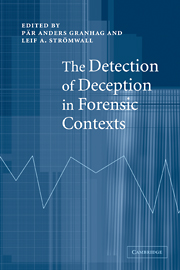Book contents
- Frontmatter
- Contents
- List of figures
- List of tables
- List of contributors
- Part 1 Introduction
- Part 2 Lie-detection techniques
- Part 3 Special issues facing a lie-catcher
- 6 Lies travel: mendacity in a mobile world
- 7 Coping with suggestion and deception in children's accounts
- 8 True or false: ‘I'd know a false confession if I saw one’
- 9 Crime-related amnesia as a form of deception
- Part 4 Enhancing lie-detection accuracy
- Part 5 Conclusions
- Index
- References
8 - True or false: ‘I'd know a false confession if I saw one’
Published online by Cambridge University Press: 22 September 2009
- Frontmatter
- Contents
- List of figures
- List of tables
- List of contributors
- Part 1 Introduction
- Part 2 Lie-detection techniques
- Part 3 Special issues facing a lie-catcher
- 6 Lies travel: mendacity in a mobile world
- 7 Coping with suggestion and deception in children's accounts
- 8 True or false: ‘I'd know a false confession if I saw one’
- 9 Crime-related amnesia as a form of deception
- Part 4 Enhancing lie-detection accuracy
- Part 5 Conclusions
- Index
- References
Summary
Let me begin with a recent story that already has historic value in the annals of wrongful convictions. This was an infamous case that took place in 1989 in New York City. Known as the ‘Central Park jogger case’, it involved a young woman, an investment banker, who was beaten senseless, raped, and left for dead. It was a heinous crime that horrified the city. The victim's skull had multiple fractures, her eye socket was crushed, and she lost three-quarters of her blood. Defying the odds, she managed to survive, but she was – and, to this day, still is – completely amnesic for the incident (Meili, 2003). Soon thereafter, solely on the basis of police-induced confessions taken within seventy-two hours of the crime, five African- and Hispanic-American boys, 14 to 16 years old, were convicted of the attack and sentenced to prison. At the time, it was easy to understand why detectives aggressively interrogated the boys, some of whom were ‘wilding’ in the park that night (Sullivan, 1992). Yet based on a recent confession volunteered from prison by a convicted serial rapist whose DNA was found in semen at the crime scene, the five boys' convictions were vacated, their confessions apparently false (Kassin, 2002; New York v. Wise, 2002; Saulny, 2002).
Four of the five jogger confessions were videotaped and presented to the juries at trial. The tapes – which showed only the confessions, not the precipitating fourteen to thirty hours of interrogation – were highly compelling.
- Type
- Chapter
- Information
- The Detection of Deception in Forensic Contexts , pp. 172 - 194Publisher: Cambridge University PressPrint publication year: 2004
References
- 11
- Cited by



